The October 2016 unemployment report shows yet more monthly distorted unemployment figures. The unemployment rate ticked down by -0.1% to 4.9% as almost half a million, 425 thousand more, were considered no longer part of the labor force. Those employed dropped by -43,000 and those unemployed declined by -152,000. Both the labor participation rate and the civilian to employment ratio ticked down a tenth of a percentage point. This report reverses any progress from last month's unemployment statistics and once again there is a feeling of static, that there is no actual progress with the real unemployment picture.
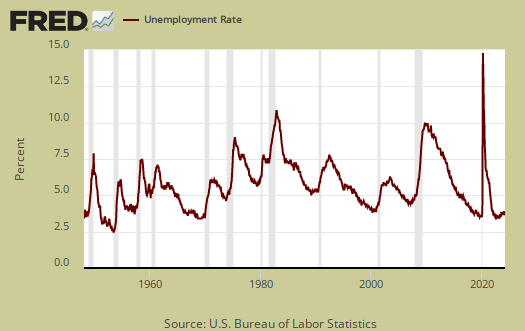
This article overviews and graphs the statistics from the Employment report Household Survey also known as CPS, or current population survey. The CPS survey tells us about people employed, not employed, looking for work and not counted at all. The household survey has large swings on a monthly basis as well as a large margin of sampling error. This part of the employment report is not about actual jobs gained, as reported by businesses, but people and their labor status.
Those employed number 151,925,000, a monthly decrease of -43 thousand. From a year ago, the ranks of the employed has increased by 2.728 million. This is still a solid annual gain.

Those unemployed decreased by -152 thousand for the month, a high monthly figure, yet from other statistics there is no guarantee these people found work. From a year ago the unemployed has decreased by only -112,000, which considering how low the official unemployed levels are, isn't a big deal.

Those not in the labor force is 94.609 million, a 425 thousand monthly gain. That's huge. The below graph are the not in the labor force ranks. Those not in the labor force has increased by 163,000 in the past year. This is really the wrong direction to see almost another half a million drop out of the labor force. One month does not a pattern make yet this just simply is not all baby boomers retiring and college students no longer participating in the labor market.

The labor participation rate is 62.8%, a -0.1 percentage point decrease Pre-recession, the January 2008 labor participate rate was 66.2% a far cry from what we see today. It just seems hard to believe that the labor participation rate has stayed so long for so long.

Below is a graph of the labor participation rate for those between the ages of 25 to 54. The rate is 81.6% and this is a 0.1 percentage point increase from last month, a very good sign in deference to the overall labor participation rate declines. This might well imply that October's massive increase in those not in the labor market is college students and retirees for this month. Ages 25-54 are the prime working years where people are not in retirement or in school full time commonly, so one should not see record low participation rates. In January 2008 the prime working years labor participate rate was 83.3%.

The civilian labor force, which consists of the employed and the officially unemployed, decreased by-195,000 to 159,712,000. The civilian labor force has grown by 2,616,000 over the past year. The BLS counts those on guest worker Visas and even illegal workers mixed in with permanent resident and citizen workers in their statistics.

Below is a graph of those not in the labor force, (maroon, scale on the left), against the noninstitutional civilian population (blue, scale on the right). Notice how those not in the labor force criss crosses the noninstitutional civilian population in growth. The civilian noninstituitonal population is from where all other labor statistics have sprung.

Below is a graph of the civilian labor force, or the official employed plus unemployed, in maroon, scale on left, against those not in the labor force, in blue, scale on right. See how those not in the labor force as a trend exceeded those considered employed and unemployed starting around mid 2009. Starting in 2014 it has reverted back, yet it oscillates starting in 2015. To have a solid employment situation those not in the labor force should be growing less than those obtaining jobs and being counted as looking for work. Those not in the labor force does include retirees and students and there is a baby bump with both of these segments of the population.
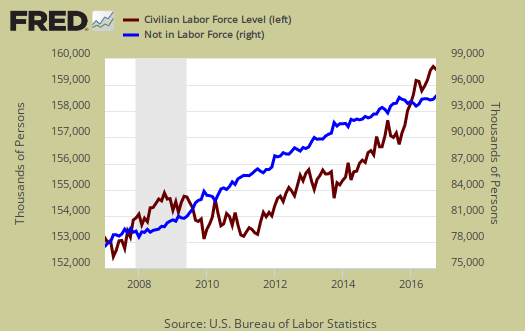
Those considered employed as a ratio to the total Civilian noninstitutional population is 59.7%, a -0.1 percentage point decrease. In January 2008, this figure was 62.9%. The relationship between the employment-population ratio and the labor participation rate (LPR) is: employment-population ratio = LPR * (1 - unemployment rate).

The number of people with part time work gives us some hints as to the kind of work being procured, since most career jobs are full time. Those forced into part time work for economic reasons stands at 5,889,000 people. This is a change of just -5,000 from last month. The annual increase of 128 thousand shows a static situation.
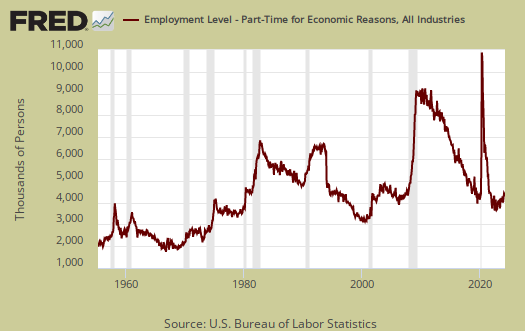
There are two categories of those forced into part-time jobs due to economic circumstances. Those who could only get part-time jobs and those already working who got their hours cut due to businesses not having enough work for them. The number of people who could only get part-time jobs stands at 2,118,000 as shown below. This is a monthly gain of 149 thousand for the month. A year ago, the number of those stuck in part-time jobs was 2,189,000, so an annual gain of 71,000 and also fairly stable for the year.
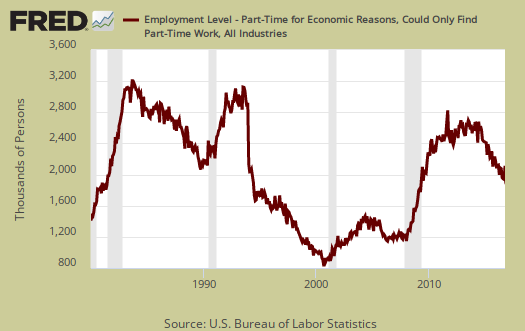
People can also work part-time hours due to slack business demand. People who got their hours cut due to slack working conditions stands at 3,505,000, a -113,000 decrease from last month. Below is a graph of forced into part-time work because they got their hours cut, as a percentage of the total employed. This is a recession economic indicator as weak economic demand forces businesses to reduce the working hours of employees.
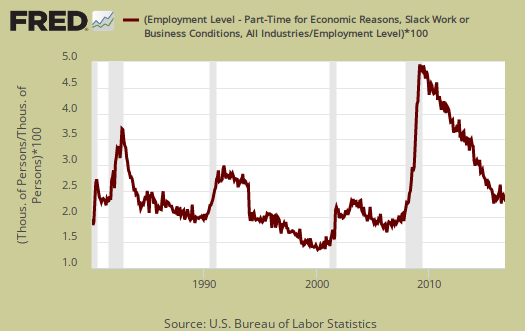
Part-time workers who are voluntarily working part-time jobs stands at 20,691,000, a monthly increase of 3,000, which is no change. From year ago those working part-time increased by 512,000.
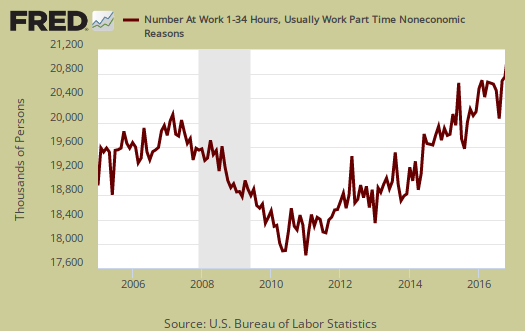
U-6 still stands at 9.5%, which is a -0.2 percentage point decline from last month. U-6 is a broader measure of unemployment and includes the official unemployed, people working part-time hours because that's all they can get and a subgroup not counted in the labor force but are available for work and looked in the last 12 months. The U-6 rate still leaves out some people wanting a job who are not considered part of the labor force, so while it is called an alternative rate, but it still ignores many who should be counted as unemployed.
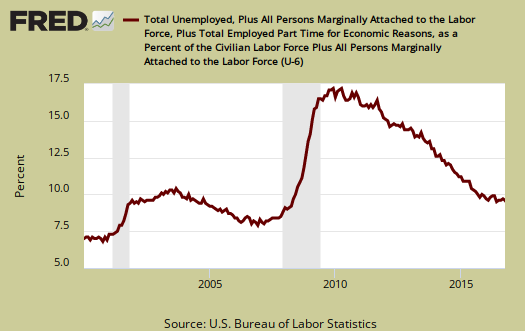
The newly unemployed stands at 2,397,000, a -177 thousand monthly decrease. Statistically speaking, BLS CPS data series are independently calculated. Below is a graph of those unemployed for less than five weeks.

The long term unemployed, or those unemployed for 27 weeks and over, is 1,979,000 people. This is a 5,000 monthly increase. From a year ago the long term unemployed ranks has declined by -71,000.
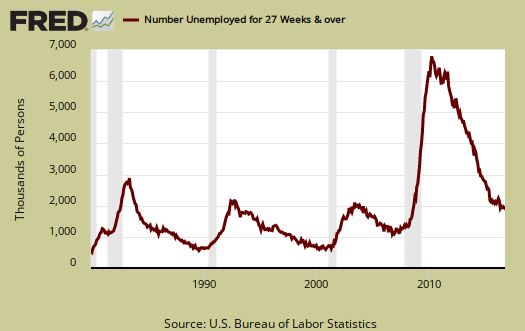
Within the CPS survey is how many people who are considered not in the labor force who report they want a job now. It is a direct survey question. The Census asks people who are not being counted in the unemployment statistics and official unemployment rate if they want a job. The number who answer yes currently stands at 5,912,000. Those not in the labor force who report they want a job declined by -127 thousand from a year ago. For the month those not considered part of the labor force who said they wanted a job declined by -176 thousand, so all of the gains happened in this month and are probably due to the wild statistical swings of the CPS report. Those who are not counted yet report they want a job includes the discouraged workers and marginally attached and is seasonally adjusted.
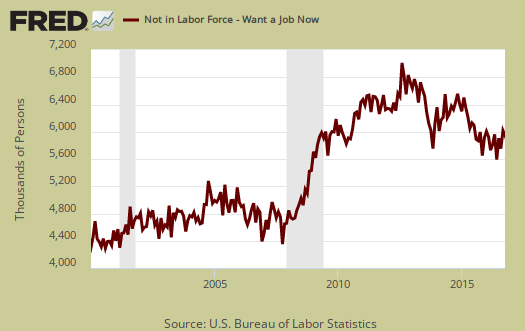
The average length of unemployment is 27.2 weeks, an decrease of 0.3 weeks from last month. The average time to be unemployed has stayed completely out of alignment with the median duration. A year ago the average duration of unemployment was 28 weeks.

The median time one is unemployed, which means 50% of people have gotten a job in this amount of time is 10.2 weeks, a change of 0.1 weeks from last month. A year ago the median time to be unemployed was 11.1 weeks.
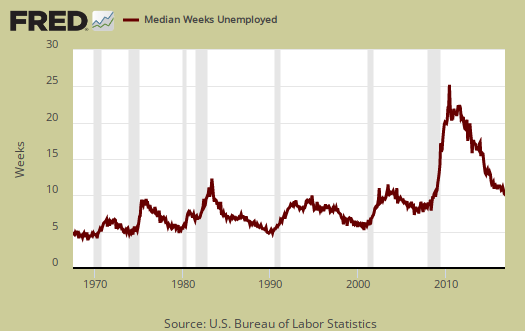
This month's CPS report by itself was fairly awful on the surface. The saving grace was the uptick in labor participation rate for prime working years. We expect these statistics to be revised in coming months and really one needs to look at the yearly trend. That said, the situation seems fairly static and it appears there are still millions of potential workers not participating in the labor market, now past eight years of the great recession. Here are our past overviews CPS unemployment statistics, only graphs revised.

Recent comments